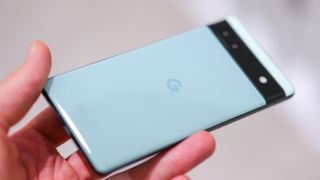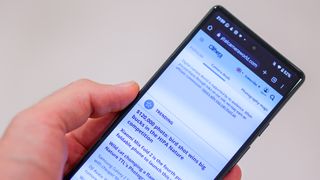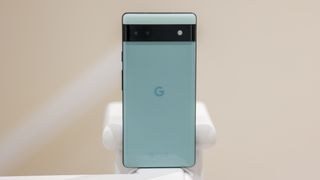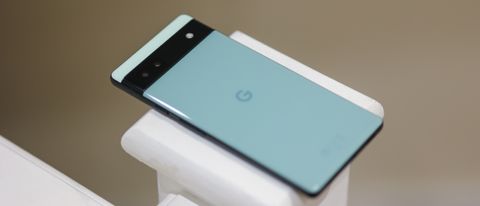The Google Pixel 6a is a hodgepodge of top-end and midrange features. Starting with the good stuff, it gets the same mighty Google Tensor processor introduced on the Google Pixel 6 and 6 Pro – so should deliver flagship performance and 5G data speeds.
Google also revisits its playful Pixel 6 styling, for a two-tone, black bar rear, and the phone's frame is a rich, blasted metal. With some competition like the Galaxy A53 5G sporting plastic at the price, things are looking good for the Google 6a's design, and it's water-resistant too.
Swipe through the 6a's interface, though, and if you've used a phone with a high refresh-rate screen, you'll notice that the 6a's screen is a bit choppier – after all, it runs at 60Hz – half that of the 120Hz Nothing Phone (1). The 6a also misses out on a new, big camera sensor, instead, getting a reprised camera setup we've seen on the Pixel 4 and Pixel 5 series.
Also read our guide to the best Android phones.
Costing $449 / £399, the same price as both Nothing's Phone (1) and Samsung's A53 5G, the Pixel 6a has some tough camera phone competition. Can updated computational photography keep things fresh despite familiar hardware, or is this a camera plateau for the midrange Pixel line?
Google Pixel 6a design and screen

If you like the Pixel 6 and 6 Pro design, the 6a's should float your boat too. Like a more compact Pixel 6, it enjoys the same black camera band around the back, bookended by two glossy panels, playing two colors off against one another. We reviewed the Sage (green) color, and it's also available in Chalk (white/grey) and Charcoal (black/grey).
While the 6a gets a premium metal frame, which is rounded to transition smoothly into the curved back of the phone, the back panel is plastic, not glass, so doesn't feel quite as rich as that of its pricier siblings.
At the base of the Pixel 6a is a USB-C port and a loudspeaker, on the right side are power and volume buttons, there's a punch hole camera centered at the top of the screen, and on the reverse is a camera band with a wide and ultra-wide camera within.
There's no doubt about it, the Pixel 6a looks fun, it's playful, and it feels good for the price. Google has design checked off, and for most, the screen will be good enough too.
Measuring 6.1 inches, the Pixel 6a's screen is smaller than that of the 6.4-inch Pixel 6, and 6.7-inch Pro. This makes it one of the smallest pixels to date, with only the Pixel 5 sporting a more compact footprint.
With a wide Full HD resolution of 1080 x 2400 pixels and a tall 20:9 aspect ratio, while things don't sound too sharp, thanks to its modest size, the phone's screen is crisp, with around 430PPI – pixels in every inch of screen. That's sharper than many flagships.
As for the screen quality, you can't argue with a good OLED display, and that's exactly what you get here. It gets bright enough to view outdoors easily, looks vibrant and deep, and its HDR credentials are recognized by apps like Netflix.
The 6a misses out on a high refresh rate screen, and that's an interesting move from Google. It is noticeable, especially when used alongside a smooth 120Hz phone. But, given the fact it's one of the best-looking, powerful phones at its price, we didn't get too hung up on that fact and don't think you will either.

Google Pixel 6a camera
The Google Pixel 6a’s main camera module features a 12.2MP resolution with an f/1.7, 27mm lens. This is nothing new, the 1/2.55" sensor has been around since the Pixel 2, combining 1.4-micron pixels, dual pixel PDAF, and OIS.
There’s no telephoto camera here, but there is an ultra-wide camera with a 12MP resolution sensor with 1.25-micron pixels, and an f/2.2, lens with a 17mm, 114˚ field of view.
While Google’s flagship Pixel 6 and 6 Pro cameras introduced new, 50MP hardware, therefore, you'll be leaning heavily on computational photography to get the most from the 6a. As for selfies, the front camera has a resolution of 8MP, combined with an f/2.0, 24mm lens.
Shooting modes include Night Sight, Portrait, Auto, Panorama, Photo Sphere and Google Lens. There’s no manual mode on the Pixel 6a, so that will put off some. However, with RAW shooting, and generally reliable exposure from the automatic mode, in addition to an on-screen exposure slider, you may well have all the controls you need nonetheless. It's also worth noting that Google's open camera API means third-party manual camera apps do work on the Pixel 6a, so you can tap into a pro mode with a download.
Google Pixel 6a camera review
When compared to phones with larger, newer sensors, there are some drawbacks to the Pixel 6a featuring a smaller, older one. As a general rule, the smaller the sensor, the worse it is at handling noise and low-light photography. Smaller sensors also produce a less shallow depth of field – in other words, less background blur. With Google's super-smart photo processing, that takes care of the noise for the most part, but the Pixel 6a can't grab natural depth of field as well as phones like the Nothing Phone (1).
Below you can see an example of how the Pixel 6a stacks up to its competition from Nothing and Samsung. White balance and image processing on the Pixel wins out, but detail and depth separation fall behind Nothing's debut. In the middle row, the ear of the teddy bear is still sharp on the Pixel 6a and A53 5G, but soft on the Phone (1)'s shot. Meanwhile, the Phone (1) still keeps the focus point, the gold 'B' nice and sharp.

Of course, there's a portrait mode, and that can artificially fill in some of the missing background blur and layer separation. Some might also prefer a more sustained depth in their photos.
More noticeable than the depth difference between the cameras is the fact Google's Pixel 6a's picture looks the best on the whole. Exposure is accurate, white balance is too, and there's a healthy amount of contrast, while shadow detail is more nuanced than it is on the Galaxy A53 5G.
As for the two camera's focal lengths, you can see below how the primary and ultra-wide photos compare when taken from the same spot. The examples captured at night are noteworthy, as they were taken in the evening when it was much darker than either photo suggest. For anyone who likes brightened-up low-light photography, the Pixel 6a is a champion, thanks to Google's camera software. This only works when a scene is still, though. Moving objects, unfortunately, turn into blurs.
Detail from the main camera is strong, but not best-in-class, so you won't want to crop into shots too much, and it's exactly the same story from the ultra-wide and the selfie camera.
The ultra-wide camera benefits from all Google's processing smarts, so despite its 8MP sensor reading poorly on paper, it still produces balanced shots that are reliably well exposed. There isn't too much warping in ultra-wide photos either, and Night Sight (night mode) fires up automatically, so you can be confident the phone will give you the best shot of taking a decent photo.
We also appreciated the Pixel 6a's selfie camera. Rather than beautifying subjects to an unrecognizable degree, it takes more classically contrasted photos, and its portrait mode's subject detection is strong in bright environments – and slightly better than average in more challenging scenes.

The Pixel 6a captures 4K video at up to 60 frames per second, and it looks excellent in bright light, held together by mighty image stabilization at maxed-out quality settings. When the lights drop, it crumbles a fair bit, but footage captured by the 6a is still usable in all but the darkest scenes.
Camera samples
Google Pixel 6a performance
The phone features a 4,100mAh battery, complete with 18W semi-fast charging which powers it up to 40 percent in around 30 minutes and charges it fully in around two hours.
The 6a doesn't support wireless charging, though does feature battery saver and extreme battery saver modes that can eke out a day or so of extra use if you're happy with dialed-back functionality. In standard mode, however, we comfortably made it through a day with moderate use, though heavy use left us needing a top-up in the early evening.
We found the under-display fingerprint scanner to work well in our time with the phone, and the dual speakers were loud enough, despite being tinny when listening for long periods. There's no headphone jack, so if you want to bypass the speakers, a converter or wireless headphones are your only option.

The Pixel 6 doesn't feature expandable storage, though its 128GB internal storage is an appropriate amount for a phone of its price and features 6GB RAM. Matched with Google’s Tensor Titan M2 chip, performance was on point, with no slowdown and decent heat management after the initial setup.
Also of note, the phone runs the latest version of Android, which balances new features with a light, easy-to-navigate interface that’s much less overbearing than UIs from the likes of Samsung and Xiaomi. When you pick up a Pixel, there’s a degree of future-proofing that you can expect, and app support is excellent.
Verdict

Google doesn't usually deliver best-in-class power, but that's what it's done with the Pixel 6a. It features a mighty Google Tensor chip with top-end features like an under-display fingerprint scanner and a premium metal frame.
Costing midrange money, though, it's clear where Google's compromised. The Pixel 6a has a lower refresh rate screen than the competition, less competitive camera hardware, and no wireless charging.
Despite its dated hardware, the 6a is a powerful camera phone thanks to Google's smart software, enjoys playful design, and offers plenty of bang for your buck.
One of the best budget camera phones out now, if not the best, the Pixel 6a, which launched at around the same time as the Nothing Phone (1) and OnePlus 10R (India only), is another excellent option for anyone after a great smartphone that doesn't cost the earth.
Read more
Best Google phones
Best camera phones
Best rugged phones
Best budget phones




